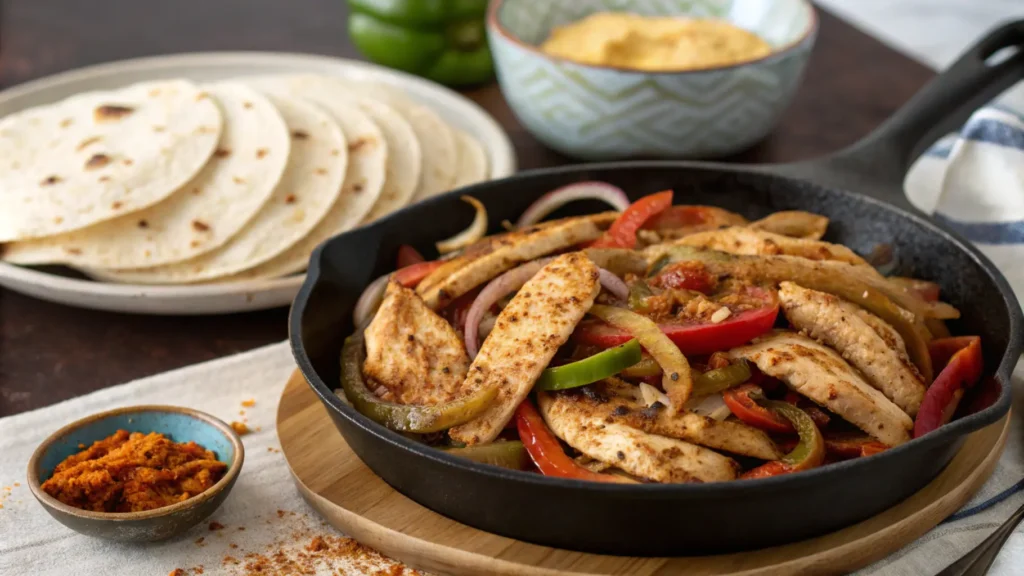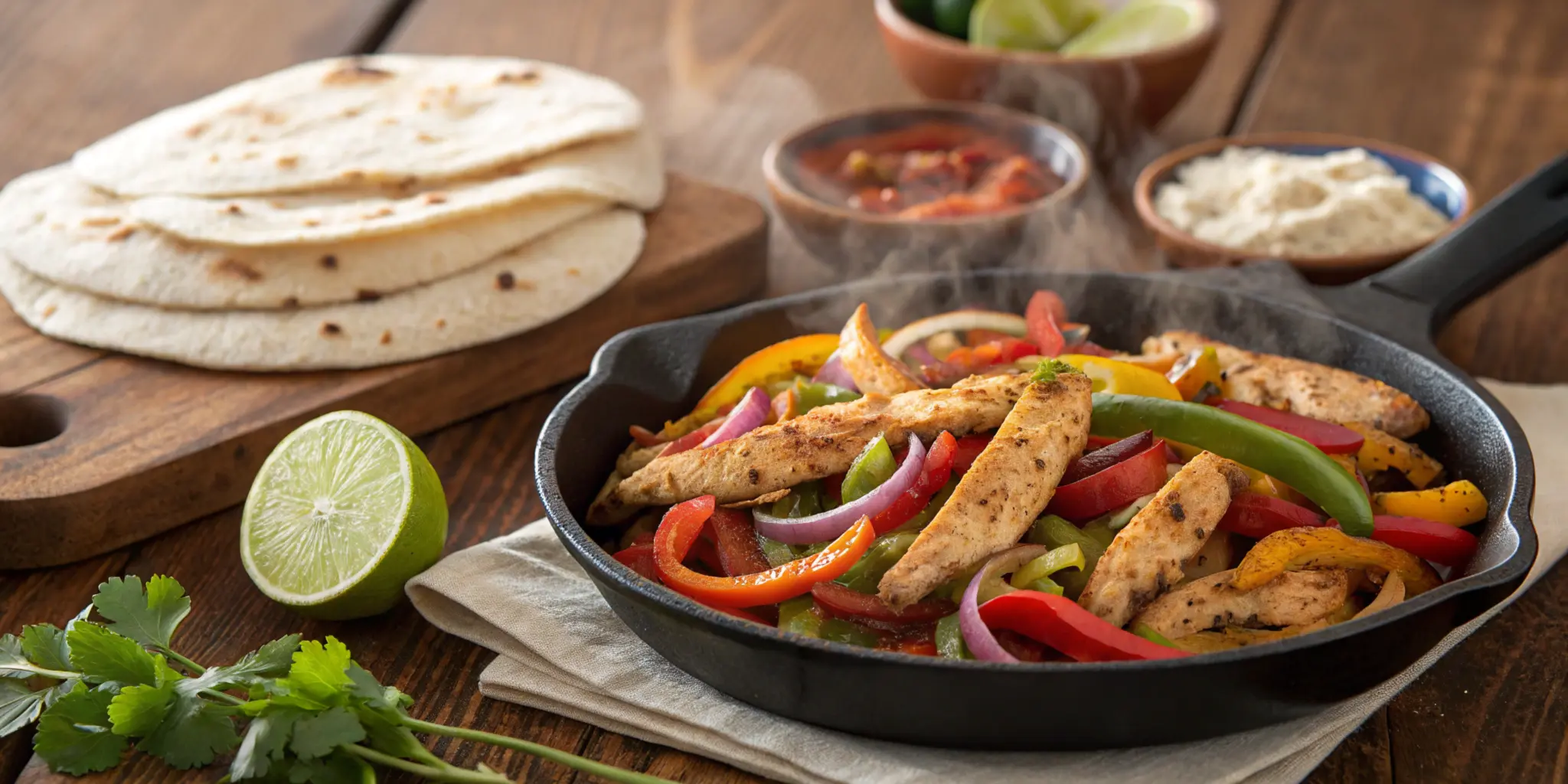What is chicken fajita seasoning made of? This flavorful blend is the unsung hero behind every sizzling, spice-packed fajita. A staple in Tex-Mex cuisine, it’s more than just heat—it combines smokiness, earthiness, and a touch of sweetness to create the perfect balance. Whether you’re making fajitas from scratch or experimenting with new flavors, understanding what goes into this seasoning will elevate your cooking. From its key ingredients to easy homemade variations, let’s dive into everything you need to know about chicken fajita seasoning.
What is Chicken Fajita Seasoning Made of? – Origins & History
The roots of fajita seasoning trace back to the vibrant flavors of Tex-Mex cuisine. Fajitas themselves, originating from the Texas-Mexico border, were born out of simplicity—marinated meat grilled to perfection and wrapped in warm tortillas. But seasoning? That’s where the magic happens. Over time, this blend evolved, incorporating traditional Mexican spices like chili powder, cumin, and paprika, making it a hallmark of Tex-Mex dishes.
Interestingly, the word “fajita” itself means “little strips,” referring to how the meat is cut before it’s seasoned and cooked. As the dish gained popularity, the seasoning blend became synonymous with the smoky, spicy profile we know today. It’s a true culinary bridge between two rich food cultures.
Why is Chicken Fajita Seasoning Important in Cooking?
What makes a fajita sing? It’s not just the juicy chicken or the charred veggies—it’s the seasoning. This blend elevates a dish from bland to bold, adding layers of complexity. Cumin provides a warm earthiness, while paprika lends a hint of sweetness and a striking red hue. Meanwhile, chili powder delivers that unmistakable kick.
But fajita seasoning isn’t just about taste; it’s also practical. It tenderizes the chicken, locks in moisture, and helps create that golden, caramelized crust we all love. Whether you’re seasoning chicken, beef, or veggies, this mix ties the flavors together, making every bite irresistible.
If you’re looking for more details on creating a flavorful marinade, check out our Ultimate Guide to Crafting the Perfect Chicken Fajita Marinade for tips and recipes.
What is Chicken Fajita Seasoning Made of? – Key Spices Breakdown
The magic of chicken fajita seasoning starts with its bold, aromatic spices. These spices form the foundation of the blend, each contributing a unique layer of flavor. Let’s break it down, one spice at a time.

Chili Powder in Chicken Fajita Seasoning – The Essential Base
When it comes to fajita seasoning, chili powder steals the show. This spice isn’t just one ingredient—it’s often a mix of ground dried chiles, cumin, garlic, and oregano. It’s the perfect multitasker, bringing heat, depth, and a touch of smokiness to the mix.
What makes chili powder so special? Its versatility. Depending on the variety you choose, it can lean spicy or mild, smoky or sweet. For fajitas, a medium-heat chili powder works best—it balances the boldness of the seasoning without overpowering the other flavors. And yes, that rich red hue it adds to the chicken? That’s all thanks to chili powder.
Fun fact: Chili powder often gets confused with paprika, but they’re not the same! Chili powder is spicier, while paprika is milder and sweeter. (More on paprika later.)
How Cumin Enhances Chicken Fajita Seasoning
If chili powder is the star, cumin is the backbone of chicken fajita seasoning. Its warm, nutty, and slightly peppery flavor ties the entire blend together. A dash of cumin is like adding a secret ingredient—it doesn’t scream for attention but subtly enriches the dish.
Cumin’s earthy aroma also complements grilled and seared dishes, enhancing the smoky char of the chicken or veggies in fajitas. But here’s the thing: too much cumin can overpower, so it’s used sparingly in fajita seasoning. A teaspoon or so is all you need to bring out its magic.
And let’s not forget its health perks! Cumin is known for aiding digestion and boosting immunity. It’s a spice that not only tastes good but also makes you feel good.
The Role of Paprika in Chicken Fajita Seasoning
While paprika might not pack the heat of chili powder, it’s essential for its sweetness and vibrant color. Made from dried and ground red peppers, paprika is the secret to the reddish tint that makes chicken fajitas so visually appealing.
There are different types of paprika, from sweet to smoked to hot. For fajita seasoning, sweet paprika works beautifully, adding a gentle warmth and balancing the sharper spices like chili powder and cumin. If you want a smoky twist, smoked paprika can step in without compromising the traditional flavor.
Plus, paprika is packed with antioxidants like vitamin C and carotenoids, giving it more than just flavor appeal. A small sprinkle goes a long way, making every bite taste—and look—amazing.
Supporting Spices and Herbs
While the primary spices set the stage, the supporting spices and herbs give chicken fajita seasoning its depth and versatility. These additions might seem subtle, but they make all the difference when it comes to flavor balance. Let’s break down the key players.
Garlic Powder: Savory Notes
Garlic powder is a seasoning powerhouse. It adds a savory richness that enhances the overall taste of chicken fajita seasoning. Unlike fresh garlic, which can be overpowering, garlic powder is mellow yet full of flavor. Its fine texture blends seamlessly into the spice mix, ensuring an even distribution of flavor across your dish.
This ingredient works behind the scenes, highlighting the other spices while lending its own garlicky warmth. Whether you’re using the seasoning on chicken, beef, or veggies, garlic powder is that comforting note your taste buds love. It’s versatile, long-lasting, and absolutely indispensable.
Onion Powder: Enhancing Flavor
Right alongside garlic powder, onion powder plays a key role in chicken fajita seasoning. This spice brings a slightly sweet, aromatic quality that complements the bolder flavors like chili powder and cumin. It has a way of rounding out the seasoning, making it taste more complete and satisfying.
What’s great about onion powder is its ability to mimic the flavor of cooked onions without the hassle. It dissolves quickly and spreads evenly, ensuring every bite is infused with that subtle, savory sweetness. If you’re a fan of onions but don’t always want to chop them, onion powder has got you covered.
Oregano and Other Herbs
Oregano is the herb that brings a hint of Mediterranean flair to chicken fajita seasoning. Its slightly bitter, earthy flavor contrasts beautifully with the warm, spicy notes of the primary spices. Oregano adds a depth that’s herbal and aromatic, making the seasoning more layered and dynamic.
Some variations of fajita seasoning may also include thyme or parsley for additional complexity. These herbs are optional but can add unique twists to the traditional blend. Together, oregano and any additional herbs create a seasoning that’s not only flavorful but also aromatic enough to make your kitchen smell amazing while cooking.
Regional Variations in Fajita Seasoning
Chicken fajita seasoning may have its roots in Tex-Mex cuisine, but it’s far from a one-size-fits-all blend. Across regions, the recipe evolves, reflecting local tastes and ingredient availability. These variations add a unique twist, making fajita seasoning adaptable to any palate.
In traditional Tex-Mex cooking, the seasoning sticks to a mix of chili powder, cumin, paprika, garlic, and onion powders. However, in northern Mexico, you might find bolder heat profiles, with ancho or chipotle powders added for smoky intensity. Meanwhile, southern U.S. variations lean into sweeter notes, often incorporating brown sugar or sweet paprika for a milder, caramelized flavor.
In coastal areas, fajita seasoning sometimes features a citrusy twist with lime zest or dried orange peel, giving it a fresher, lighter profile. This version works beautifully with seafood fajitas, highlighting the bright, tangy flavors. The beauty of fajita seasoning lies in its flexibility—whether you prefer heat, sweetness, or zest, there’s a regional version for you.
Adjusting Heat Levels: Mild to Spicy
One of the best things about chicken fajita seasoning is how easy it is to customize the heat level. Whether you’re cooking for spice enthusiasts or those with a milder palate, tweaking the spice blend can make all the difference.
For a milder seasoning, focus on sweet paprika and reduce the amount of chili powder. You can even substitute part of the chili powder with a smoky paprika for depth without too much heat. Adding more garlic and onion powders can also help tone down the spiciness, creating a balanced but flavorful blend.
On the other hand, if you crave heat, the options are endless. A dash of cayenne pepper or crushed red pepper flakes will take the spice level up a notch. For a smoky heat, chipotle powder is an excellent addition, delivering both fire and a robust, earthy aroma. Remember, it’s always easier to add heat than to take it away, so start with small amounts and adjust as needed.
Incorporating Citrus Elements
Citrus plays a surprising yet impactful role in chicken fajita seasoning. Adding a tangy, zesty element can brighten the overall flavor and balance the bold spices. While lime juice is commonly used when marinating fajitas, incorporating citrus directly into the seasoning blend can take it to the next level.
Dried lime zest or powdered lemon peel works well in dry seasoning mixes. These ingredients bring a punch of tanginess without the moisture, making the seasoning more versatile. They’re especially great for giving chicken fajitas a fresher flavor profile, reminiscent of classic Mexican dishes.
For an added layer of complexity, you might consider experimenting with orange zest or even grapefruit powder. Not only do these options lend a subtle sweetness alongside the tang, but they also make the seasoning perfect for dishes that need a vibrant, fruity lift. Furthermore, citrus-infused fajita seasoning pairs beautifully with seafood and vegetables, which makes it a creative way to expand your Tex-Mex repertoire.
Benefits of Homemade Seasoning
Making your own chicken fajita seasoning at home isn’t just about control; in fact, it’s about crafting a blend that perfectly suits your taste buds. On the other hand, store-bought seasoning mixes often contain preservatives, anti-caking agents, or unnecessary fillers like excess salt or sugar. By choosing the homemade route, you can skip all of that and stick to pure, flavorful spices.
One of the greatest advantages of homemade seasoning is the customization it offers. You can tweak the heat level, play with sweetness, or even add a citrusy kick—all based on what you love. For instance, if you have dietary restrictions, it’s no problem at all. Homemade seasoning allows you to create gluten-free, low-sodium, or even salt-free blends with ease.
Additionally, let’s not forget the cost savings. Buying bulk spices and making your own mix is far more economical than purchasing prepackaged blends. Moreover, you’ll enjoy a fresher-tasting seasoning that hasn’t been sitting on a store shelf for months. Homemade seasoning is fresher, healthier, and more versatile. So why settle for anything less?
Step-by-Step Guide to Creating Your Blend
Ready to whip up your own chicken fajita seasoning? Here’s a foolproof recipe that you can customize to your heart’s content.
Ingredients:
- 2 tablespoons chili powder
- 1 tablespoon ground cumin
- 1 tablespoon paprika (sweet or smoked)
- 1 teaspoon garlic powder
- 1 teaspoon onion powder
- 1 teaspoon dried oregano
- ½ teaspoon cayenne pepper (optional, for heat)
- ½ teaspoon salt (adjust to taste)
- ½ teaspoon black pepper
Instructions:
- Measure the spices: Start by measuring out all your ingredients into small bowls or directly into a mixing bowl. Using fresh, high-quality spices makes a noticeable difference in flavor.
- Mix them together: Combine all the spices in a bowl and stir thoroughly until the mixture is uniform in color and texture. A whisk works well for even blending.
- Taste and adjust: Take a small pinch and taste it. Want more heat? Add cayenne pepper. Prefer more garlic? Toss in a bit more garlic powder. The beauty of this recipe is its flexibility.
- Store your blend: Transfer the seasoning mix to an airtight container or spice jar for storage. Label it with the date, so you know how fresh it is when you use it again.
That’s it! In less than 10 minutes, you’ve created a flavorful, preservative-free fajita seasoning that’s perfect for chicken, veggies, and more.

Storage Tips for Freshness
To keep your homemade fajita seasoning fresh and aromatic, proper storage is key. Spices are sensitive to air, light, and moisture, which can cause them to lose their potency over time.
- Use an airtight container: Mason jars, spice jars with tight-fitting lids, or even small resealable bags are excellent choices. Avoid leaving the seasoning exposed to air.
- Store in a cool, dark place: Keep your seasoning away from heat sources like stovetops or direct sunlight. A kitchen cabinet or pantry works perfectly.
- Label and date your jar: Spices don’t last forever. Homemade seasoning is best used within 6 months for optimal flavor. After that, it may still be safe to use but might lack the punch you’re looking for.
- Avoid moisture contamination: Always use a dry spoon to scoop out your seasoning. Even a small amount of moisture can clump the spices or cause them to spoil.
Taking these steps will ensure that every time you open your jar, your seasoning smells just as vibrant as the day you made it.
Seasoning Chicken for Fajitas
When it comes to making the perfect chicken fajitas, the seasoning is the star of the show. It’s what transforms simple cuts of chicken into a dish bursting with bold Tex-Mex flavor. The key is not just the seasoning itself but how and when you apply it.
Start with boneless, skinless chicken breasts or thighs. Both options work wonderfully, but thighs tend to be juicier and hold up well to high-heat cooking. Coat the chicken with a generous amount of fajita seasoning, ensuring every piece is evenly covered. A tablespoon of seasoning per pound of chicken is a good starting point.
For even better results, mix the seasoning with a splash of olive oil and lime juice to create a marinade. Let the chicken soak in the mixture for at least 30 minutes—though an hour or two will give you even more flavor. The lime juice not only enhances the taste but also tenderizes the meat, making it irresistibly juicy. When you’re ready to cook, use a hot skillet or grill to sear the chicken, locking in the seasoning and creating a smoky, caramelized crust.
Beyond Chicken: Other Proteins and Vegetables
Fajita seasoning isn’t just for chicken. Its versatility makes it a go-to blend for other proteins and even vegetables. If you’re a fan of beef, fajita seasoning works wonders on skirt steak, flank steak, or even ground beef. The smoky, spicy flavors pair beautifully with red meat, creating a hearty, satisfying dish.
Seafood lovers can use fajita seasoning on shrimp, white fish, or even scallops. The seasoning’s zesty kick enhances the natural sweetness of seafood. Just be sure to use a lighter hand, as seafood requires less seasoning than denser proteins.
For plant-based fajitas, this seasoning shines on roasted or grilled vegetables. Bell peppers, onions, zucchini, and portobello mushrooms are classic choices, but don’t stop there. Sweet potatoes, cauliflower, or even chickpeas can be seasoned and roasted for a hearty, vegetarian twist. Coat the veggies in olive oil and sprinkle the fajita seasoning generously before cooking for a burst of flavor.
Creative Culinary Uses of Fajita Seasoning
Chicken fajitas are just the beginning. Fajita seasoning can be a secret weapon for spicing up countless dishes in your kitchen. For example, use it to elevate roasted potatoes or sprinkle it over popcorn for a Tex-Mex-inspired snack. Toss it with cooked rice or quinoa for a side dish that pairs perfectly with grilled meats or veggies.
You can even use fajita seasoning in soups and stews. Add a teaspoon or two to chicken tortilla soup or chili for a smoky, spicy kick. It’s also fantastic for seasoning scrambled eggs, omelets, or even breakfast burritos. The combination of spices works beautifully with eggs and cheese, adding an unexpected burst of flavor.
For dips and spreads, mix fajita seasoning into sour cream or Greek yogurt for a quick, flavorful dip. It’s also great in guacamole, adding depth without overpowering the avocado’s creamy richness. Whether you’re looking to spice up everyday dishes or try something new, fajita seasoning is a culinary multitasker that never disappoints.

Nutritional Profile of Common Ingredients
The spices and herbs in chicken fajita seasoning not only pack a flavorful punch but also come with nutritional perks. Each ingredient contributes its unique benefits, making the seasoning a healthier choice compared to many prepackaged alternatives. Let’s take a closer look at what these ingredients bring to the table.
- Chili Powder: A staple in fajita seasoning, chili powder is rich in vitamins A and C, which support immunity and skin health. It also contains capsaicin, a compound that may help boost metabolism and reduce inflammation.
- Cumin: Known for its warm, earthy flavor, cumin is a powerhouse of antioxidants. It’s a great source of iron and has been linked to improved digestion and blood sugar regulation.
- Paprika: Besides adding a sweet or smoky taste, paprika provides a healthy dose of vitamin E, essential for maintaining skin and eye health. It’s also packed with carotenoids, antioxidants that support overall well-being.
- Garlic Powder: This ingredient is more than just flavorful—it’s been associated with heart health and immune support. Garlic contains compounds that may help lower blood pressure and cholesterol levels.
- Onion Powder: Like garlic, onion powder contributes savory notes while delivering small amounts of antioxidants and compounds that may support heart health.
- Oregano: This herb isn’t just aromatic; it’s also loaded with antioxidants and has antimicrobial properties. It’s a great addition to any spice mix for both flavor and health benefits.
Nutritional benefits
| Ingredient | Nutritional Benefits | Key Nutrients |
|---|---|---|
| Chili Powder | Rich in antioxidants and vitamins, supports immunity, and may boost metabolism. | Vitamins A, C, capsaicin |
| Cumin | Aids digestion, supports blood sugar control, and provides essential minerals. | Iron, antioxidants |
| Paprika | Adds sweetness and color while providing antioxidants that promote skin and eye health. | Vitamin E, carotenoids |
| Garlic Powder | Known for heart health benefits and boosting immunity. | Allicin, antioxidants |
| Onion Powder | Supports heart health and contains small amounts of beneficial compounds. | Sulfur compounds, antioxidants |
| Oregano | Contains antimicrobial properties and is packed with antioxidants. | Polyphenols, vitamins A and C |
If you’re interested in learning more about the health benefits of these spices, Healthline offers a wealth of detailed information.
Together, these ingredients create a seasoning blend that’s as nutritious as it is delicious. By skipping the additives and fillers often found in store-bought mixes, you’re left with pure, healthful spices.
Managing Sodium and Additives
One common concern with seasoning blends, especially store-bought ones, is their sodium content. Many commercial fajita seasonings rely heavily on salt as a cheap way to enhance flavor. Unfortunately, this can lead to unnecessarily high sodium intake, which isn’t ideal for heart health.
When making your own fajita seasoning, you’re in full control of the salt level. A little salt can enhance the overall flavor, but it’s entirely optional. For a low-sodium or salt-free version, simply omit the salt and let the spices shine on their own. The combination of chili powder, cumin, paprika, and garlic powder provides enough depth and complexity without relying on sodium.
Another downside of store-bought mixes is the inclusion of additives like anti-caking agents and artificial flavors. These are used to preserve shelf life or improve texture but add no real value to the flavor. Homemade seasoning eliminates the need for these extras, leaving you with a clean, natural blend.
For those watching their sodium or seeking a more natural diet, making fajita seasoning from scratch is an easy and rewarding solution. Not only do you avoid unnecessary additives, but you also create a mix that’s perfectly tailored to your tastes and health goals.
Frequently Asked Questions
How long does homemade fajita seasoning last?
Homemade fajita seasoning can last up to 6 months if stored properly. Keep it in an airtight container, away from heat, moisture, and direct sunlight. Over time, the spices may lose their potency, so it’s best to make smaller batches for maximum freshness and flavor. Always use a dry spoon when scooping the seasoning to avoid clumping or contamination.
How to make chicken fajita marinade?
To make a simple and flavorful chicken fajita marinade, mix the following ingredients:
- 3 tablespoons of olive oil
- Juice of 2 limes
- 2 tablespoons of fajita seasoning
- 2 garlic cloves, minced
- 1 tablespoon of soy sauce (optional for depth)
Combine the marinade ingredients, pour over chicken, and let it sit for at least 30 minutes to an hour in the fridge. This blend not only enhances the chicken’s flavor but also tenderizes it for juicy, delicious fajitas.
For an easy, step-by-step approach to crafting a mouthwatering marinade, don’t miss our How to Make the Best Chicken Fajita Marinade: Easy Step-by-Step Guide.
What is a good marinade for chicken fajitas?
A good marinade for chicken fajitas balances spice, acid, and oil. Use fajita seasoning as the base, then add lime juice for tanginess and olive oil to coat the chicken evenly. Garlic, onion, or a splash of orange juice can also add extra depth. For a smoky edge, a hint of smoked paprika or chipotle powder is excellent.
To discover what makes a truly great marinade for chicken fajitas, check out our What Is a Good Marinade for Chicken Fajitas? Ultimate Guide.
What is fajita marinade made of for chicken?
The typical fajita marinade includes:
- Fajita seasoning (chili powder, cumin, paprika, garlic, and onion powders)
- Citrus juice, such as lime or orange, for a zesty kick
- Olive oil to bind the flavors and keep the chicken moist
- Optional additions like soy sauce, Worcestershire sauce, or honey for sweetness
This combination brings out bold, zesty flavors while tenderizing the chicken to perfection.
For a complete breakdown of what goes into a chicken fajita marinade, visit our What Is Fajita Marinade Made of for Chicken? Complete Guide.
Can you marinate fajitas too long?
Yes, you can marinate fajitas for too long. If the marinade contains citrus (like lime or orange juice), marinating for more than 24 hours can break down the chicken’s proteins too much, resulting in a mushy texture. Ideally, marinate chicken fajitas for 30 minutes to 2 hours for the best balance of flavor and texture.
What is the formula for chicken marinade?
The general formula for a chicken marinade is:
- 3 parts oil (olive oil or avocado oil)
- 1 part acid (lime juice, lemon juice, or vinegar)
- 1–2 tablespoons of seasoning per pound of chicken (fajita seasoning, taco spice mix, or other blends)
Optional ingredients include garlic, honey, soy sauce, or fresh herbs, depending on the flavor profile you want. This simple ratio ensures a flavorful, balanced marinade every time.
Conclusion
Chicken fajita seasoning is more than just a spice blend—it’s a flavor-packed combination of ingredients that brings the essence of Tex-Mex cuisine to your kitchen. From its key spices like chili powder, cumin, and paprika to its versatile supporting ingredients such as garlic powder and oregano, every element plays a vital role in creating its signature taste.
Making your own fajita seasoning at home offers unmatched flexibility. Whether you prefer a smoky twist, a zesty citrus flair, or a fiery kick, you can customize the blend to suit your preferences. It’s healthier, fresher, and free of unnecessary additives found in store-bought mixes.
Beyond chicken fajitas, this seasoning can transform vegetables, seafood, and other proteins or add Tex-Mex magic to everyday dishes like soups, roasted potatoes, and dips. It’s a seasoning that not only tastes great but also complements a nutritious lifestyle, thanks to the benefits of its wholesome spices and herbs.
So, whether you’re preparing a quick weeknight meal or experimenting with new recipes, chicken fajita seasoning is your go-to for bold, delicious flavors. Try it homemade—you’ll wonder how you ever cooked without it!

